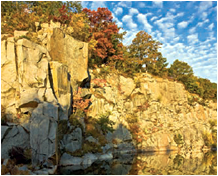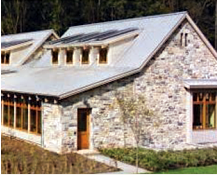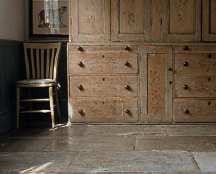
Congratulations on your decision to select natural stone! The stone industry takes being "green" extremely seriously. Natural stone is Mother Nature's original green building material. It is neither bonded together by petroleum based resins nor created in a factory. Natural stone flooring and countertops will not need to be replaced for a long time, are 100% recyclable, do not emit VOCs into your home and can be cleaned with Ph-neutral dish detergent. After all, what can be greener than a product that comes directly from the earth?
Read on to learn what steps we are taking to research and promote sustainable business practices to companies in the stone industry. You will also learn how to use stone to support a green building design project. Stone's position as a green building material and in the green building community are backed by comprehensive research. Competing materials often claim to be green. But, stone's enduring life cycle, ease of care and maintenance and durability make it an excellent choice for your project.
A sustainable or green building is the outcome of a design process which focuses on increasing the efficiency of resource use — energy, water, and materials — while reducing a building's impact on human health and the environment during its life cycle; through better site selection, design, construction, operation, maintenance, and eventual disposal or removal.
Click here to get the latest research results including material fact sheets for granite, marble, limestone, and sandstone.

For over 65 years the Natural Stone Institute has been the world's leading information resource and advocate for the natural stone industry. Natural Stone Institute members include marble, granite, limestone, sandstone and other natural stone producers and quarriers, fabricators, installers, distributors and contractors around the world. The Natural Stone Institute is a proud member of the Natural Stone Council and the U.S. Green Building Council.
With the growing popularity of the U.S. Green Building Council's (USGBC) Leadership in Energy and Environmental Design (LEED) program and the National Association of Home Builders' (NAHB) National Green Building Standard for residential building, green building has become an integral part of the design and construction industry. The Natural Stone Council (NSC), a collaboration of natural stone industry businesses and trade associations, assessed the industry's environmental footprint, then published case studies to highlight what environmentally-conscious companies are doing to become more "green". NSC also developed best practices so that stone industry companies have a roadmap for "greening" their companies. The NSC is now partnering with The University of Tennessee Center for Clean Products to conduct needed research, and to help promote the results to the green building community.
In the past 15-20 years, the business of quarrying has improved enormously from an environmental perspective. Domestic quarries today are required to comply with strict guidelines and are monitored by MSHA (Mine Safety and Health Administration) among others. Also, many old quarries have been and continue to be turned into state parks, golf courses, lakes and recreations areas, and most working quarries in the US, Canada and Europe have reclamation plans in place for when operations are finished.

Enduring Life Cycle
Natural stone stands up to weathering and time better than any other building material, natural or manmade. This has been proven through the ages. The Egyptian pyramids, the Parthenon or any ancient city offer lessons that demonstrate natural stone is the most sustainable building material available.
Durable
When choosing to install a stone floor, countertop, wall cladding, etc. you are making a decision to use a product that will last for at least 100 years in many cases and certainly for the life of the building in most.
Recyclable
No other building material is as recyclable as natural stone. Nearly 100% of stone from deconstructed projects is recyclable and able to be used on other projects, or crushed for use as roadbeds, etc.
Zero VOC Emission
Research conducted by the University of Tennessee's Center for Clean Products found that natural stone does not directly emit any VOCs (Volatile Organic Compounds). Stone may source VOCs from adhesives and applied sealants, however, low- and no-VOC options are available.

Water Recycling
Domestic stone fabricators utilize a water filtration system for their waste water. However, many companies are also on the cutting edge of an exciting new closed loop water recycling system. These closed loop systems recycle 100% of water used in the fabrication of natural stone, dramatically lowering water consumption.
Heat Island Affect
Many light-colored varieties of natural stone have been shown to lower a building's or site's "heat island" through their ability to reflect heat. Heat island refers to the concept of a building raising the average temperature of the area surrounding a building and site.
Regional Material
A major tenet within the green building rating systems is that of supporting "local" products and businesses. Regionally manufactured and extracted materials reduce environmental impacts by reducing emissions of greenhouse gasses during transportation, while supporting local economies. Fortunately for environmentally conscious consumers, there are stone quarry sites within 500 miles of nearly any building site in the United States and Canada.